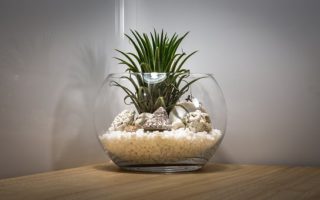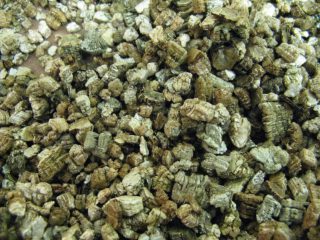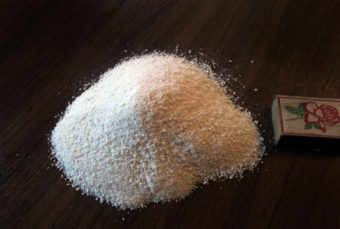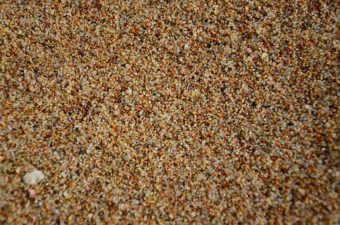In this article, the perennial question to which substance is better to add to your potting mix will be answered. In previous posts I have always highlighted the importance of having good drainage but how is this to be done.
You have three main substances that can be added and mixed with the compost to make it more open structured and therefore more free-flowing and free-draining.

Vermiculite, perlite and horticultural grit are all the substance in question that can be used, but which is the best to use in containers?
This question will be hopefully answered in this article. It may not be definitive because the answer may depend on your growing conditions and on your previous gardening experience.
VERMICULITE
Vermiculite is the name of a group of laminar hydrated silicates of aluminium, iron, and magnesium. This natural mineral is heated to a high temperature, which converts it to a lightweight, highly absorbent flakes.
Expanded vermiculite has many unique and versatile characteristics. It has a low density, non-combustible, highly absorbent, pH neutral, non–reactive and can be compacted. The heating process ensures that a large surface area product is made and when mixed with compost ensure that it is water retentive.
When vermiculite is used with fertilizers it helps to retain water and nutrients, only returning to the plants when it requires it.
Vermiculite is widely used in commercial hydroponics, in seed starting, plants rooting, and as a soil conditioner. It makes the compost more moisture-retentive, as it can absorb 4 times its weight in water.

The vermiculite will stop the soil from being too compacted, it makes the compost more aerated and free draining. It will improve seed germination and will increase root growth.
Normally vermiculite is made up of 1 to 5mm particle in size, this is what it is ideal to cover your seeds with, as it will offer better contact and will help your seed retain the moisture around it for much longer.
This is one of the major uses of vermiculite, as it is often found in seed compost mixes. I would recommend covering all seed with a thin layer of vermiculite if the seed needs covering as some seeds need light to germinate, and therefore do not require covering.
WHEN TO USE VERMICULITE?
Vermiculite has better moisture-retentive capabilities compare to perlite, as it is more absorbent, with a better open structure with many open pores, allowing water to reside in them.
The best use of vermiculite would be for plants that need their roots in constant moisture. It is not recommended for use with plants who do not like getting their roots waterlogged, such as cacti and succulents.
The optimal application rates are as follows:
For seed germination apply a sprinkle on top of seeds in tray and pots is sufficient. You do not need to add much, only enough to make a thin layer.
For pots a mixture of 50% compost to 50% vermiculite is sufficient. As vermiculite is much more expensive than compost you can reduce this to 25% vermiculite to 75% compost, as long as an open structure is generated. The ratio of compost to vermiculite is not important as long as a free-flowing, free-draining compost is made. This is where experience comes into play.
There are 3 grades of vermiculite that is often sold; fine, medium, and coarse. Fine is perfect for seed germination, whilst coarse is more tailored for water retention in containers.
ADVANTAGES AND DISADVANTAGES OF VERMICULITE
Advantages of using vermiculite include:
- Lightweight
- Does not decompose.
- Improve water retention and nutrient availability, whilst returning nutrients and water when the plant needs it.
- Improves seed germination, whilst reducing the likelihood of dampening off disease.
- Improve soil structure and some better aeration properties.
Disadvantages are:
- It is not a cheap product especially if you need a large supply of it.
- It can be dusty and so better to use in a well-ventilated area.
The product that I recommend for vermiculite is Gro-Sure Vermiculite 10 litres.
PERLITE
Perlite is a naturally occurring volcanic rock that is non-toxic, which is heated to a high temperature to produce a product that is light and porous. It is heated up to 825 degree Celsius, where little, porous balls are produced, that expand 13 times its original size. Its composition is 70 to 75% silicon dioxide 12 to 15% aluminium oxide, 3- 4% sodium oxide, 3-5% potassium oxide, 0.5 to 2% iron oxide, 0.2 to 0.7% magnesium oxide and 0.7- 1.5 % calcium oxide.
The main advantage of perlite compared to vermiculite is that it retain air much more, making it an ideal compost additive.

Air is essential for the support of plant life as that of the compost itself. It is also required for the steady breakdown of organic matter and therefore the nutrients that are released. The movement of air is necessary to avoid the build-up of toxic gases, so air needs to be able to diffuse through the compost particle.
Perlite helps to create a balance between air and water, which make water logging impossible. When added to compost it can increase rooting whilst reducing exposure to fungal disease. Just like vermiculite, it comes in three grades of fine, medium, and coarse.
Perlite can act as an insulator preventing plants from being exposed to temperature shifts. Perlite is ideal to use from propagating plant cuttings. To use it at optimal growing condition, it is best to mix one part perlite to one part compost. This will make the compost more open structured and ideal for repotting your container plants.
ADVANTAGES AND DISADVANTAGES OF PERLITE
The advantages of using perlite include:
- Lightweight
- Improve aeration and drainage for healthy root systems.
- Ideally used to propagate root cuttings and to pot on plants that do not require much moisture
- For the same volume used it is cheaper than vermiculite.
- Ideally for potting on seedlings.
- Naturally occurring product, which is environmentally friendly and will not cause contamination.
Disadvantages include:
- Very dusty, so use in well-ventilated areas.
- It will still be costly if you have lots of containers to fill.
When moving a plant from one container to another it is best to use 25% perlite, with or without any sand/grit added. This will create a light and very open structure, improve drainage, aeration, and insulation. Water the plant well in the original container and allow it to drain. You can then place it in the perlite compost mixture water well and feed when necessary.
For hardwood cuttings, you need to use two parts perlite to one part compost. Keep it well watered until the cutting has rooted. It will then need to be potted on to a multipurpose compost in a pot of the right size.
For soft cuttings, use a mixture of equal parts by volume of perlite and compost, then follow the procedure for soft cuttings. As you can see the product ingredients are different for hard and soft wood cuttings.
The product that I would recommend is Horticultural Medium Grade perlite 100 litre bag
HORTICULTURAL GRIT
Grit is finely graded small stone particles that are used to improve the drainage in composts. It normally consists of 2 to 4mm particles that have been washed and graded via sieves.
Horticultural grit has been used by gardeners and professional growers for a number of years. It helps to promote better drainage and aeration in any compost. It is great to use for cactus plants, alpines, herbs, and lavender plants.

Horticultural grit produces small pockets of air which will benefit the plants in the container no end. As an added bonus you can use it as a top dressing for any container. This means you can have grit within the container and on top of the compost within the container.
One of the main advantage is that using grit will add weight to any container, making it less likely to be blown down in strong winds. To add the right amount of grit to the containers, you will need to add 50g of this product per 1 litre of compost (this is about a handful).
PERLITE AND HORTICULTURAL GRIT CAN BE USED IN THE SAME COMPOST MIX
It must be noted that perlite and horticultural grit can be mixed within the same compost. In this way, you are able to alter the weight of your containers. Add more perlite than grit and your container will be lighter, use more grit than perlite and you container will be heavier.
The ratio of compost to perlite to horticultural grit can therefore be tailored to your needs. If you want a plant that will not blow down add more grit. If you want a plant in a container that is easy to move, add more perlite. The heaviest being compost and grit, whilst the lightest will be compost and perlite. The option to which one to use is left up to you.
You can say that perlite and horticultural grit has quite similarly uses.
ADVANTAGES AND DISADVANTAGES OF USING HORTICULTURAL GRIT
The advantages of using horticultural grit include:
- The cheapest of all three options.
- Tightly graded, lime-free for your container garden needs.
- Improve aeration and drainage.
- Ideal for cacti, alpines, herbs, and lavender. Other plants that hate waterlogged roots can also be potted into a compost and grit mixture.
- Make a great decorative top dressing for plants in containers,
- Tried and tested method
- Unlike the other two, much less dust is produced.
The disadvantages are:
- It is heavy compared to the other two additives, 20 litres will weigh around 28kg, which is more than 10 times the weight of vermiculite or perlite of the same volume.
The product I would recommend is Westland Potting Grit, 20kg.
VERMICULITE, PERLITE OR HORTICULTURAL GRIT, WHICH SHOULD I USE?
This is not an easy question to answer, as it is so much dependent on what you want to use it for, and what plant is growing in the container you wish to move the plant to.
- If you want to germinate seeds and you want to get better germination rates, use vermiculite sprinkled on top of seeds trays full of seed compost.
- If you want to propagate soft or hard cuttings, use perlite.
- If you want to repot to a mixture which is water retentive and the plant must have constantly wet roots then vermiculite is the product to go for.
- If you want to decorate the top of a container then horticultural grit is for you.
- If you want to rehouse your plant to a mixture that is dry and light then add perlite.
- If you want to rehouse your plant to a heavier container that does not blow down in strong winds, then you can use a mixture of perlite, horticultural grit and compost. For lighter mixtures use more perlite, for heavier mixtures use more horticultural grit.
- If you want to rehouse your plant to the heaviest and most stable mixture that is cheaper than horticultural grit is for you.
CONCLUSIONS
In this article, the discussion of which substance to add to compost to make it more draining has been enclosed. As you can see that are three products that can improve aeration and drainage but all have different uses, as highlighted by the previous section of this article. Perlite and horticultural grit have similar uses and can be used by themselves or together in different proportions.
Perlite is used for better aeration, whilst vermiculite is used for more water retention.
Three different products, three different uses. The articles should hopefully have cleared up which product to use when and where.
If you have a question or a comment you wish to make, please do so in the comment box below.
Thanks




This article is great and straight to the point. I have been wondering for a while which substance I should be using in my containers and came to the conclusion finally to choose grit because of your post. Basically summed up what I needed to know and which substance to you use in different cases. Thanks so much.
HI Abbas
It is so confusing to know what substance to add to your potting mix, so my guide should have cleared up. Thank you for your kind words and hope all the success in the near future.
Kind Regards.
Antonio
This was a good article for someone who may be just starting out with gardening and horticulture. Your breakdown of the advantages and disadvantages of the three types of additives was done very well and gives the reader a chance to make an informed decision. Your writing style also makes it that you don’t try to “sell” one particular additive over the other. Great post!
Hi Nightwulf
I do not believe in hard selling but giving people a free choice. It is always good to see what is in front of you but presented in a more palatable way.
Thanks
Antonio
Thanks for your very detailed post on the differences between Vermiculite vs Perlite vs Horticultural Grit. I am not a huge gardener by any means but do enjoy it from time to time. I was apparently under the false impression that you can use Vermiculite with Perlite. But I see from your article that it would be Perlite and Horticultural Grit that can be used together. Thanks again.
Hi Robb
Glad to be of service.
Kind regards
Antonio
Another interesting and very useful article that I can put into action almost immediately and thanks for that. This one drills down a bit on the vermiculite versus perlite or horticulture grit issue (which is better?) and is information I needed to know about.
I think you never will know it all, but to continue to learn is better than thinking you know it all. This site helps me in that regard. Depending on who I talk to in the garden center, each will have their opinion. The explanations you offer as to when to use each and for what purpose is the most complete I have come across to now.
There will still be some experimentation that I use when using all three, but I have a much clearer idea of when each might be appropriate for the particular goals I have (i.e. germinating). Thanks once again for a useful post that is packed full of information!
Hi Dave
There is so much information out there but there is nothing that compares all three substances until now. I wanted to clear it up once and for all. Your kind words have told me that you think that I have
Kind regards
Antonio
I like your post and its really educating. I didn’t know if perlite before now, this post has widen my garden container knowledge. I think the three substance have their own peculiar use and sometimes the kind of plant determines the kind of substance to be used. I never knew Grit and perlite can be mixed together in a container, so. Thanks for the post, its very useful.
Hi Jones
My task in life is to educate and bring useful information for people, and from your kind remarks I think I have succeeded.
Kind Regards.
Antonio
Hello! Very interesting article you have written and I must say that you have successfully bisect the juxtaposition between these three. Though the one I make use of in my garden is horticultural grit majorly. I do not know of the other two before actually. I like the feel and the beautification added to my garden through the use of horticultural grit. The compost is less dusty and I like it a lot. Though I have learnt on the other two too and I will try them out anytime soon. With that, I can ascertain the best for me
Hi RoDarrick
Thsnk you once again for providing a well constructed response to my article and I am glad your knowledge had been extended. I always leave up to the individual to decide which is the best.
Kind regards
Antonio
The three do have their own advantages and disadvantages. My mum is the one who is into container gardening and so I know very little about which is better but my mum has been using the vermiculite to add to her compost. She’s been thinking of starting some other container plants and don’t know if it’ll go on well with the other plants. I think she’ll have to read this to decide based on what plants she’s planning on planting. Apart from using them in containers, can they also be sued in open gardening?
Hi John
Thank you for those kind words and to answer to you question is that vermiculite and perlite would be too expensive to use in open gardens, but the grit in small amount can be used. If you want to prove the drainage in open ground it is better to use building sand as it is much more cheaper.
Thanks
Antonio
Wow, I never knew there were supplements like this that can be added to the soil to help with retaining water and even drainage. So many time when my kids are left ti water the plans they either add too much water or less, worse was when I got a really bad compost, after a while it couldn’t take water. Now I’ll make sure to add these supplement to every compost I get. But now which would you suggest I get?
Hi Chloe
I always leave the decision to you, as you cannot go wrong with all three. The decision is dependent on your budget, what you plan to do and its availability. If you want to stop watering too much you can read my review on Watering Spikes- 5 of the Best Reviewed
Thank you for your kind words
Antonio
Thank you for the detailed information; your site has been a huge help for me!
I am planning to plant some black elder bushes next spring. Would you suggest getting them now in the fall and growing in a container through the winter season to give them a head start? And if so, which of the above products would you recommend I use for this particular plant? I appreciate your insight and advice – thank you in advance!
Hi Shan
Thank you for those kind words as you have brightened up my day..
Yes you can buy the black elder bush now and keep them in the container. You can leave them outside as frost should not damage them but if you want to offer some protection you can use
Rowlinson Hardwood Mini Greenhouse, a Review (Is it Worth the Price?)
Thanks
Antonio
Thank you for this article! Very easy to read with some very useful information. Personally, my favorite of the three is vermiculite! I just LOVE the way that it looks in an open vase. However, with my cacti (which I LOVE), my go-to is horticulture Grit. I just am not a fan of the perlite… it tends to make so much of a mess! I did learn some valuable information here that I was unaware of. Thank you again! I look forward to reading more of your articles.
Hi Dr Baker
Thank you for your kind words. It is always good to read of other people’s experiences, which brings much more meaning to my article. You are very welcome to visit my website and provide insightful comments.
Thank you
Antonio
Just what I needed to know! I’ve been watching Gardner’s World on BritBox (BBC). I had never heard the term ‘grit’ before, but it was constantly used on this program. Looked like big grains of sand: bigger than sand, smaller then even the smallest pebbles. Thank you so much for the definitions, the pros and cons, everything!
Hi Thisni
This is my pleasure I thought I would write a concise article that will help everybody.
Thanks
Antonio